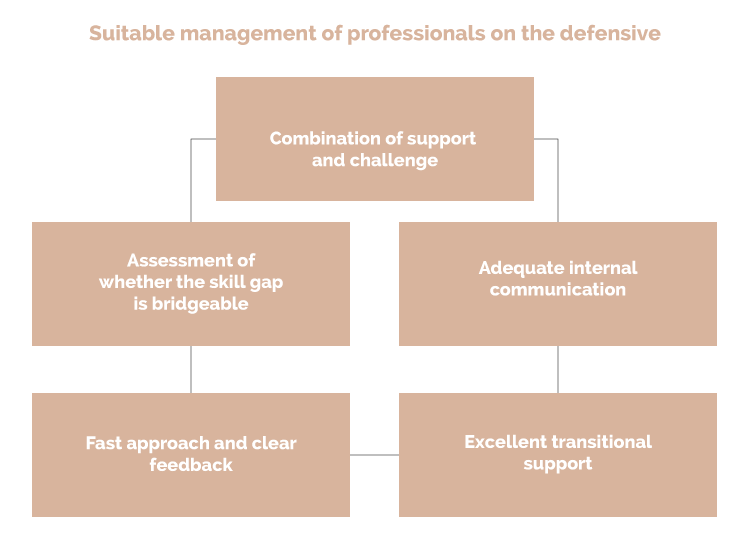Professionals on the defensive: how to help them? David Reyero – Diario de Levante – May 14
It is obvious that we are currently experiencing a period of profound economic and social change which, in many organizations, is termed as “triple transformation”: global (which derives from the economic crisis and obliges us all to reinvent ourselves both personally and professionally), sectoral (linked to new competitive requirements in many different industries) and internal (based on the implementation of numerous transformation management programs).
In my contacts with colleagues from many different companies, we frequently discuss the role Management and Human Resource Committees should play in order to successfully lead such transformations, and an important aspect I have recently much reflected upon is how to help professionals “on the defensive”..
I am referring to employees who tend to have a high level of commitment and have, in the past, been solid contributors, or even high-performance and/or role models in terms of their skills, and who, as a result of relevant internal and external changes, have (apparently) ceased to offer successful professional profiles.
This rather painful situation frequently causes such employees to experience a sense of loss of control in terms of their careers and the perception that a change is necessary, although they are often unsure as to which direction to take or how to step out of their comfort zones and continue to be added-value professionals in the framework of their companies. This is also often combined with a perception of “having professionally missed out” and they are also faced with varyingly transparent advice and opinions from their superiors as to the urgent need for them to further develop their profiles. They are, therefore, subject to an environment of uncertainty as to how to evolve quickly in order to recover their role in the company and adapt to new key professional skills.
In recent years, such cases have multiplied due to the outbreak of the crisis and the context of profound change in numerous companies, and I believe it is essential to deal with these situations in a rigorous manner, suitably combining the interests of the company and the sensitivity and support such employees undeniably deserve.
Here is a non-exhaustive list of best practices based on my experience in dealing with complex situations which call for individual in-depth analysis:

1. Fast approach and clear feedback
Leaving such complex situations on stand-by for fear of conflict or on the basis of the illusion that time will heal them is a mistake that tends to aggravate the diagnosis and possible cure in that it usually gives rise to a context of latent conflict and poor communication, serving to reduce mutual trust and reaction time for the employee in question to develop his or her new profile. A rapid response makes it easier for everyone involved to seek a swift solution, increase the chances of success or, at least, to improve the reputation of the company as good employers in terms of people management in the event of the employee’s finally leaving the organization.
2. To assess whether the skill gap is “bridgeable”
As in any performance assessment, clear communication relating to current performance in terms of what is essential (fulfilment of objectives) and how (skill profile) and future prospects is absolutely fundamental. What makes these situations somewhat different is the need to discuss, in an honest and in-depth manner, the real possibilities of development and adaptation to the new profile and internal relocation options. In such cases, the role of Human Resources should facilitate and mediate to ensure quality dialogue in potentially conflictive issues and open up professional alternatives in terms of development and/or internal or external relocation which are, occasionally, far from obvious.
As a final option, if the gap is considered to be excessive and there are no reasonable options to relocate within the company, it is recommendable to apply a suitable departure date from the organization with an adequate internal and external communication plan, while, at the same time, striving to minimize the potential market-value loss of the employee in question.
3. Combined support and challenge
Once the rules of the game and the existing alternatives have been clearly defined, it is important to create a context of self-commitment and self-responsibility and, at the same time, to provide the employee with professional development tools aimed at his or her individual and specific needs. Initiatives such as continuous feedback from the manager (or other colleagues) relating to daily performance, coaching, mentoring, 360° feedback and formalized collective or individual development programs (when necessary) may be fruitful when properly applied, together with a positive focus and a well balanced support/challenge approach.
In terms of the successful cases in which I have participated, the employee’s perception of being helped by the company with specific tools for his or her development is just as important as the self-conviction that the new context calls for a deep and rapid profile evolution which, albeit clearly a challenge, will also serve to guarantee future professional success.
4. Adequate internal communication
Any decision regarding company employees is thoroughly scrutinised by other professionals. I believe that, within any company framework, we are not sufficiently aware of this or of the potential impact it might cause, as we are too often focused on the day-to-day maelstrom that tends to prevent us from taking a more pondered view thereupon.
It is essential to build and to communicate a real and honest story, whether the conclusion of the process is for the employee to continue in his or her current role with reinforced skills, to be internally relocated or to finally leave the company. It is well known that such considerations serve to create the “genuine culture” of any organization, beyond the dictates of official corporate values.
In each particular case, we should assess which formal or informal communication channels to use and be fully aware that, if we do this well, it will be clearly beneficial to the company’s reputation and help create an organizational environment that will greatly facilitate skill transformation oriented towards business and towards the future.
5. Excellent transitional support
When the decision is to maintain the employee in his or her current position, it will be essential to elaborate a swift development plan supported by the manager and Human Resource department (in addition to other internal or external figures, when necessary) or to provide a suitable plan to accommodate the employee in a new internal-move location. Such lines of support will greatly facilitate the future performance of the “renewed professional” and his or her integration in everyday responsibilities.
If the final decision, however, is to leave the company, it is indispensable to preserve both the internal and external image by managing the departure with social responsibility. Negotiating appropriate conditions and a suitable external-relocation plan with a view to reducing the professional transition period to a minimum should be valued as elements of reputational investment and not just as a cost factor to be minimized in a period of crisis.
In conclusion, I believe that such situations should be addressed with the utmost professionalism by all team-leading company members, whether Management or Human Resource staff, and I find that there is a definite lack of teaching and training on such issues, not just in the context of companies but also in advanced educational scenarios such as University and Master’s Degree courses.
Many specialists claim that, in the coming years, we will be faced with a scenario of volatility, uncertainty, complexity and ambiguity and, therefore, the agility to learn and unlearn will be key elements in winning the race to employability. So, will you play defensively or go on the attack?

Leave a Reply